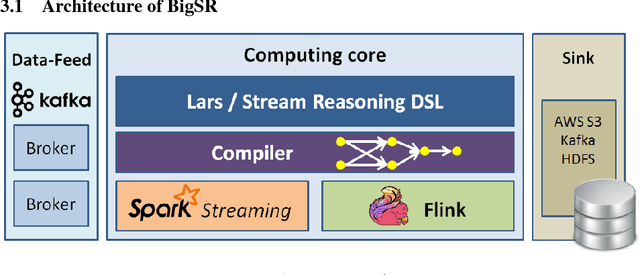Olivier Curé
ZodiacEdge: a Datalog Engine With Incremental Rule Set Maintenance
Dec 22, 2023Abstract:In this paper, we tackle the incremental maintenance of Datalog inference materialisation when the rule set can be updated. This is particularly relevant in the context of the Internet of Things and Edge computing where smart devices may need to reason over newly acquired knowledge represented as Datalog rules. Our solution is based on an adaptation of a stratification strategy applied to a dependency hypergraph whose nodes correspond to rule sets in a Datalog program. Our implementation supports recursive rules containing both negation and aggregation. We demonstrate the effectiveness of our system on real and synthetic data.
BigSR: an empirical study of real-time expressive RDF stream reasoning on modern Big Data platforms
Apr 12, 2018



Abstract:The trade-off between language expressiveness and system scalability (E&S) is a well-known problem in RDF stream reasoning. Higher expressiveness supports more complex reasoning logic, however, it may also hinder system scalability. Current research mainly focuses on logical frameworks suitable for stream reasoning as well as the implementation and the evaluation of prototype systems. These systems are normally developed in a centralized setting which suffer from inherent limited scalability, while an in-depth study of applying distributed solutions to cover E&S is still missing. In this paper, we aim to explore the feasibility of applying modern distributed computing frameworks to meet E&S all together. To do so, we first propose BigSR, a technical demonstrator that supports a positive fragment of the LARS framework. For the sake of generality and to cover a wide variety of use cases, BigSR relies on the two main execution models adopted by major distributed execution frameworks: Bulk Synchronous Processing (BSP) and Record-at-A-Time (RAT). Accordingly, we implement BigSR on top of Apache Spark Streaming (BSP model) and Apache Flink (RAT model). In order to conclude on the impacts of BSP and RAT on E&S, we analyze the ability of the two models to support distributed stream reasoning and identify several types of use cases characterized by their levels of support. This classification allows for quantifying the E&S trade-off by assessing the scalability of each type of use case \wrt its level of expressiveness. Then, we conduct a series of experiments with 15 queries from 4 different datasets. Our experiments show that BigSR over both BSP and RAT generally scales up to high throughput beyond million-triples per second (with or without recursion), and RAT attains sub-millisecond delay for stateless query operators.
RDF Knowledge Graph Visualization From a Knowledge Extraction System
Oct 01, 2015

Abstract:In this paper, we present a system to visualize RDF knowledge graphs. These graphs are obtained from a knowledge extraction system designed by GEOLSemantics. This extraction is performed using natural language processing and trigger detection. The user can visualize subgraphs by selecting some ontology features like concepts or individuals. The system is also multilingual, with the use of the annotated ontology in English, French, Arabic and Chinese.
 Add to Chrome
Add to Chrome Add to Firefox
Add to Firefox Add to Edge
Add to Edge